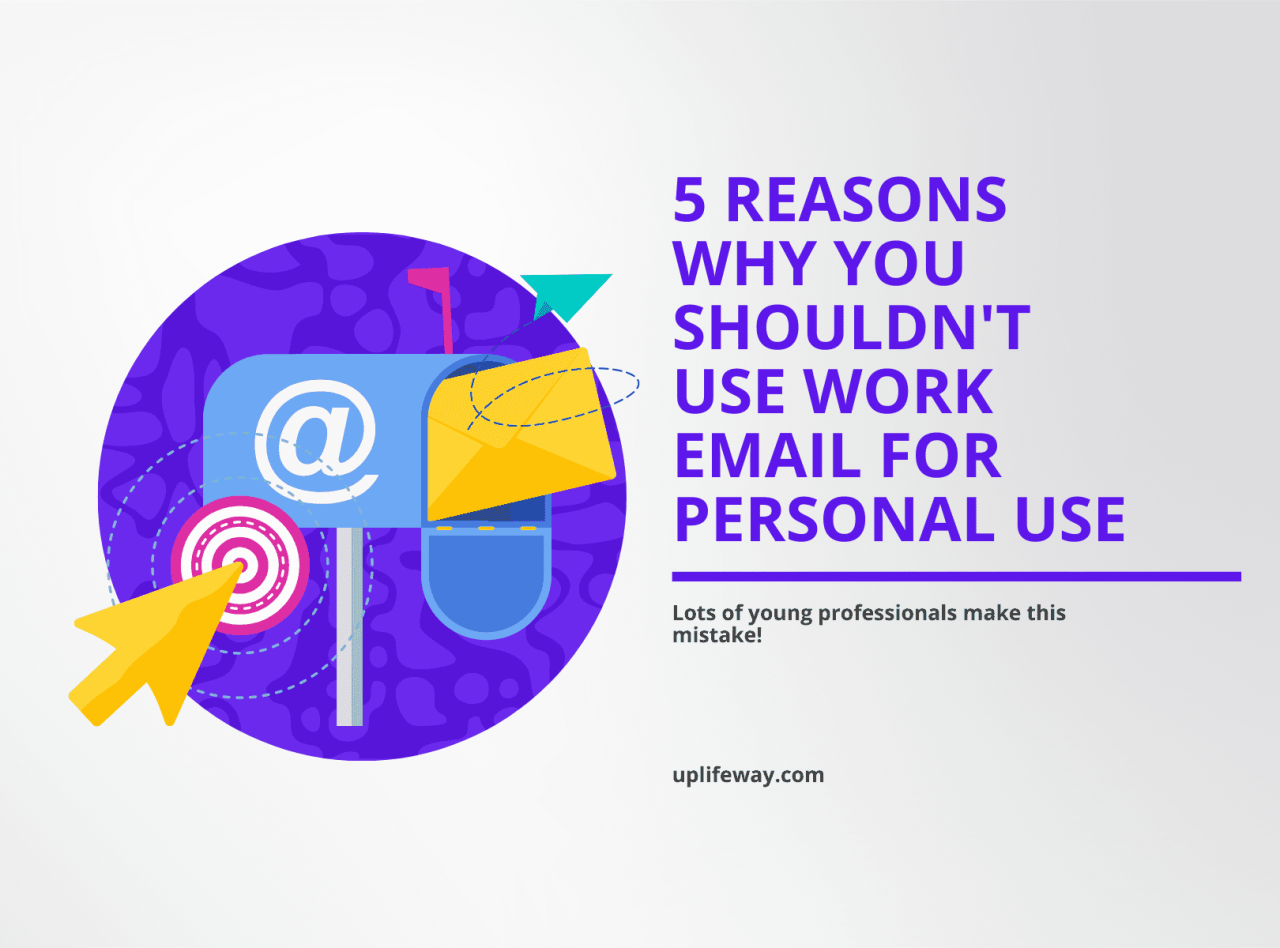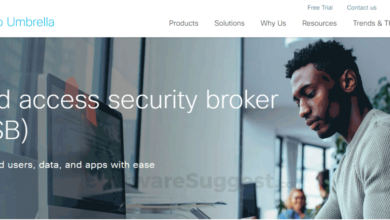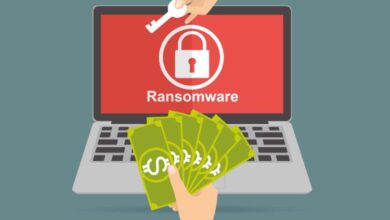
The Dangers of Employees Using Personal Email on a Work Device
The dangers of employees using personal email on a work device are far more significant than many realize. It’s a seemingly small act, but it opens a Pandora’s Box of security risks, legal headaches, and productivity nightmares. This seemingly innocuous practice can expose your company to devastating data breaches, costly lawsuits, and a significant drain on efficiency. Let’s dive into the specifics and explore how to mitigate these very real threats.
From malware infections spread through seemingly harmless emails to the complex legal issues surrounding data ownership and privacy violations, the consequences of allowing personal email on company devices are substantial. We’ll examine real-world scenarios, explore best practices for data security, and Artikel a clear policy to protect your business. Understanding these risks is the first step towards creating a safer and more productive work environment.
Security Risks
Using your personal email account on a work device creates a significant security vulnerability, exposing your company’s sensitive data to potential threats. This seemingly innocuous practice can have far-reaching consequences, leading to data breaches, financial losses, and reputational damage. The interconnected nature of modern technology means that a compromised personal account can quickly compromise your work environment.The primary risk stems from the lack of control companies have over personal email accounts.
Corporate security measures, such as firewalls, anti-malware software, and data encryption, typically do not extend to personal accounts. This leaves the organization exposed to various threats, including malware, phishing attacks, and unauthorized access to sensitive data.
Data Breaches Resulting from Personal Email Use
The potential for data breaches is amplified when personal email is used on work devices. Accidental forwarding of confidential documents, unintentional exposure of sensitive information through email attachments, and the potential for malware to spread across the work device are all significant risks. For instance, an employee might inadvertently attach a confidential client proposal to a personal email and send it to the wrong recipient.
Or, a malicious attachment in a personal email could infect the work device, granting attackers access to company networks and data. This breach could expose intellectual property, customer data, or financial information, leading to significant financial and legal repercussions for the company.
Malware and Phishing Attacks Facilitated by Personal Email
Personal email accounts are often less secure than corporate accounts and are more susceptible to malware and phishing attacks. Malicious actors can use sophisticated techniques to exploit vulnerabilities in personal email providers to deliver malware directly to the work device. Phishing emails targeting personal accounts can trick employees into revealing their login credentials, granting attackers access to both their personal and potentially work accounts if the same passwords are used.
A simple example would be an employee clicking on a link in a seemingly harmless personal email that installs malware, giving attackers access to company files stored on the work device or network.
Best Practices for Securing Company Data When Personal Email is Involved
While using personal email on work devices is discouraged, understanding the risks and implementing appropriate security measures can help mitigate the potential damage. However, complete elimination of risk is unlikely without a policy against this practice.
| Security Measure | Effectiveness | Implementation | Considerations |
|---|---|---|---|
| Strong, Unique Passwords | High | Enforce password complexity and rotation policies. | Employee training on password security is crucial. |
| Multi-Factor Authentication (MFA) | Very High | Implement MFA for both personal and corporate accounts. | May require employee education and acceptance. |
| Regular Security Awareness Training | Medium to High | Educate employees on phishing, malware, and social engineering tactics. | Training needs to be regular and engaging. |
| Data Loss Prevention (DLP) Software | High | Implement DLP software to monitor and prevent sensitive data from leaving the corporate network. | Requires investment in software and infrastructure. |
Compliance and Legal Issues
Using personal email for work-related communications might seem harmless, but it opens a Pandora’s Box of compliance and legal headaches. This practice significantly increases the risk of violating various regulations and exposes your company to potential lawsuits. The consequences can be severe, ranging from hefty fines to reputational damage.Ignoring the potential legal ramifications of mixing personal and professional communication on company devices is a serious oversight.
The risks are amplified when considering the sensitive nature of much of the data handled by businesses today. Let’s delve into the specifics.
Data Privacy Law Conflicts
Mixing personal and work emails on a work device creates a significant risk of violating data privacy laws like GDPR (General Data Protection Regulation) and CCPA (California Consumer Privacy Act). These regulations impose strict rules on how personal data is collected, stored, and processed. When personal emails containing sensitive information are stored on a company device, the company becomes responsible for ensuring its security and compliance with these laws.
A data breach involving both personal and work-related data could lead to substantial fines and legal action. For example, if an employee’s personal email containing health information is accessed during a security breach on a company device, the company could face significant penalties under HIPAA (Health Insurance Portability and Accountability Act) regulations.
Industry-Specific Regulations
Many industries have specific regulations that govern the handling of sensitive data. For example, financial institutions are subject to strict regulations under laws like SOX (Sarbanes-Oxley Act) which require careful record-keeping and data security. Healthcare providers must comply with HIPAA regulations, which protect patient health information. Using personal email for work-related communication in these industries could lead to non-compliance and severe penalties.
A hospital employee using their personal email to discuss patient information could result in a HIPAA violation, leading to substantial fines and reputational damage for the hospital.
Scenarios Leading to Legal Trouble
Several scenarios illustrate how using personal email for work-related communications can create legal problems. Imagine a company employee using their personal email to discuss a confidential merger or acquisition with a third party. If this email is intercepted, the company could face legal repercussions for breaching confidentiality agreements or violating insider trading laws. Similarly, an employee using their personal email to communicate with a client could lead to issues if the client’s data is compromised.
The company could be held liable for data breaches or failure to protect client information, even if the communication originated from the employee’s personal account on a company device. The company’s liability stems from the fact that the communication occurred using company resources and potentially involved company data.
Productivity and Efficiency
Using personal email on work devices significantly impacts employee productivity, often in ways that are subtle but cumulatively detrimental. The constant influx of personal messages, notifications, and the mental juggling act required to switch between professional and personal communication can lead to significant time losses and decreased focus on core work responsibilities.The inherent nature of personal email often involves a less structured and more emotionally charged communication style than professional email.
This can lead to longer response times, increased emotional investment in non-work matters, and a general decrease in the ability to efficiently manage work tasks. The constant temptation to check personal emails, even for brief moments, disrupts concentration and flow, impacting the quality and speed of work output.
Distraction and Time Wasted Due to Personal Email Management
The constant stream of personal emails, social media notifications, and other non-work related communication vying for attention on a work device is a major productivity drain. Even seemingly quick checks can lead to a cascade of further distractions, leading employees down rabbit holes of social media browsing, online shopping, or lengthy email threads unrelated to work. This fragmentation of attention significantly reduces the time available for focused work, ultimately impacting project deadlines and overall efficiency.
For example, a study by the University of California, Irvine, found that it takes an average of 23 minutes to regain focus after an interruption. Imagine the cumulative impact of multiple such interruptions throughout a workday. This constant switching of context and the effort required to refocus significantly reduces overall output.
Comparison of Company Email and Personal Email for Work Tasks
Using a company email for work-related tasks offers several key advantages over using a personal email. Company email systems are typically designed for efficient communication and collaboration, often integrating with other work tools and offering features like shared calendars, task management systems, and secure file sharing. This streamlined workflow enhances productivity and reduces the time spent on administrative tasks.
In contrast, using a personal email for work-related communications can lead to logistical challenges, such as difficulties in accessing work-related files, collaborating with colleagues, and maintaining a clear audit trail of communications. The lack of integration with company systems and the potential for security breaches associated with personal email further diminish its efficiency for professional use. For instance, a company relying on personal email for client communication might struggle to meet compliance requirements or face difficulties in retrieving crucial information if an employee leaves the company.
Strategies for Improving Employee Productivity by Enforcing Company Email Usage, The dangers of employees using personal email on a work device
Implementing a clear policy that mandates the use of company email for all work-related communication is a crucial step towards improving employee productivity. This policy should be communicated effectively to all employees, along with training on best practices for email management and the importance of maintaining a professional communication style. Providing employees with access to efficient email management tools and training on these tools can further enhance their ability to manage their workload effectively.
Regular monitoring and enforcement of the policy, coupled with providing alternative communication channels for personal matters (e.g., dedicated break times, designated personal devices), can create a more focused and productive work environment. For example, a company could implement a system where personal email access on work devices is restricted during core work hours, promoting focused attention on professional tasks.
Data Ownership and Control

Using personal email for work purposes creates a murky landscape regarding data ownership. The lines between personal and company information blur, leading to potential conflicts and significant security risks. Understanding who owns what data and how to manage it is crucial for both the employee and the employer.The challenges of establishing clear data ownership are numerous. Company policies often state that all work-related data belongs to the company, but enforcing this when that data resides on a personal account is difficult.
Furthermore, personal email often contains a mixture of work and personal communications, making separation and retrieval of company data a complex and time-consuming task.
Data Retrieval Challenges
Retrieving company data from personal email accounts presents several hurdles. Simple downloading of emails isn’t always sufficient, as attachments may be scattered, emails might be deleted or archived, and the personal email provider’s search functionality might be inadequate for comprehensive retrieval. The process often requires legal intervention or cooperation from the employee, which may not always be forthcoming, especially in cases of disputes or employee departures.
Consider the scenario where an employee leaves suddenly, taking with them years of client communication and project details held within their personal inbox. Recovery could be incredibly difficult, leading to potential loss of valuable business information and client relationships.
Risks Associated with Employee Departure
When an employee leaves a company, the risk of losing valuable company data increases exponentially if work-related emails were stored in their personal account. The departing employee might retain access to sensitive information, such as client lists, financial data, or confidential strategies, potentially using it for personal gain or sharing it with competitors. Even if the employee has no malicious intent, the simple act of retaining access to company data creates a security vulnerability.
A former employee’s compromised personal email account, for instance, could grant unauthorized access to sensitive company data.
Company Data Ownership Policy
A clear and comprehensive policy is essential to address these issues. This policy should explicitly state that all data created or received during work hours, using company equipment or resources, belongs to the company, regardless of where it’s stored. The policy should Artikel employee responsibilities, including the prohibition of using personal email for work-related communication, the obligation to promptly hand over all work-related data upon termination, and the potential consequences of non-compliance.
A well-defined process for data retrieval in case of employee departure should also be established. For example, the policy might require employees to forward all relevant emails to a company-designated account before leaving, or allow for remote access to the employee’s personal email account for data retrieval under specific, legally compliant circumstances. This policy should be easily accessible, regularly reviewed, and acknowledged by all employees.
Illustrative Scenarios

Let’s look at some real-world examples of what can go wrong when employees use personal email on company devices. These scenarios highlight the risks and demonstrate the importance of clear policies and robust security measures. Understanding these examples can help prevent similar incidents in your own workplace.
The following scenarios illustrate the potential negative consequences of mixing personal and professional email on work devices. Each scenario highlights a different risk, emphasizing the importance of a clear separation between personal and professional communication within the workplace.
Scenario 1: Accidental Data Exposure
Imagine Sarah, a marketing manager, uses her personal email to discuss a new campaign strategy with a colleague. She forgets to switch accounts and accidentally forwards a confidential document containing sensitive client data to her personal contact list, which includes family and friends. This breach exposes sensitive company information and violates client confidentiality agreements.
- Situation: Sarah uses her personal email on her work laptop to discuss confidential campaign details.
- Negative Outcomes: Sensitive client data is exposed, potentially leading to legal repercussions, reputational damage for the company, and loss of client trust. Sarah faces disciplinary action.
- Remediation Steps: Implement a clear policy prohibiting personal email use on work devices. Provide employee training on data security and confidentiality. Implement data loss prevention (DLP) tools to monitor and block the transmission of sensitive information.
Scenario 2: Malware Infection Through Phishing
John, a sales representative, receives a phishing email in his personal inbox while working on his company laptop. He clicks a malicious link, unknowingly downloading malware onto the company device. This malware compromises the company network, potentially exposing sensitive customer and financial data.
- Situation: John uses his personal email account on his work computer and falls victim to a phishing scam.
- Negative Outcomes: Malware infects the company network, leading to data breaches, system downtime, and potential financial losses. The company faces significant costs related to remediation and potential legal liabilities.
- Remediation Steps: Implement robust security software and firewalls on all company devices. Provide regular security awareness training to employees, focusing on phishing scams and malware prevention. Regularly update software and operating systems.
Scenario 3: Legal and Compliance Issues
Maria, a project manager, uses her personal email to communicate with a vendor regarding a project. The emails contain sensitive information related to project budgets and contracts. If the company is audited, the lack of proper record-keeping and the use of a personal email account could lead to significant legal and compliance issues.
- Situation: Maria uses her personal email for project communication, failing to maintain proper records within the company’s system.
- Negative Outcomes: During an audit, the lack of proper documentation and the use of a personal email account could result in fines, legal action, and reputational damage. The company could face difficulty demonstrating compliance with relevant regulations.
- Remediation Steps: Implement a comprehensive email management policy requiring all work-related communication to be conducted through company-approved channels. Ensure regular archiving and backup of all company emails. Provide training on relevant legal and compliance regulations.
Visual Representation of Data Flow and Security Breaches
Imagine a diagram with two distinct boxes: one labeled “Company Network” and the other labeled “Personal Email Account.” Arrows represent the flow of data. A solid, thick arrow goes from “Company Network” to “Personal Email Account,” representing the employee accessing personal email on a work device. Several thinner, dotted arrows branch off from the “Personal Email Account” box, going to various external locations like “Social Media,” “Public Wi-Fi,” “Unsecured Servers,” and “Malicious Actors.” These dotted arrows represent potential security vulnerabilities and data breaches.
Each endpoint has a small icon representing the risk: a padlock with a crack for insecure servers, a virus symbol for malware, and a person with a question mark for data exposure to unauthorized individuals. The diagram clearly shows how using personal email on a work device creates multiple pathways for data leaks and security breaches, highlighting the interconnected risks involved.
Policy Recommendations
Implementing a robust policy regarding personal email use on company devices is crucial for mitigating the risks discussed earlier. A clear, concise, and enforceable policy will protect your company’s data and ensure compliance with relevant regulations. This section Artikels a sample policy and recommendations for employee education.
Company Policy on Personal Email Use on Work Devices
The following policy prohibits the use of personal email accounts on company-owned devices, including laptops, desktops, tablets, and smartphones. Violation of this policy may result in disciplinary action, up to and including termination of employment.
- Prohibition: The use of personal email accounts on company-owned devices is strictly prohibited. This includes accessing, sending, or receiving personal emails during work hours or on company property.
- Exceptions: Exceptions to this policy may be granted only with prior written approval from the IT department and the employee’s direct supervisor. Such exceptions must be documented and justified based on legitimate business needs. Even with approval, the use of personal email should be minimized.
- Monitoring: The company reserves the right to monitor all activity on company-owned devices, including email traffic, to ensure compliance with this policy and to protect company data.
- Consequences of Violation: Violation of this policy may result in disciplinary action, ranging from verbal warnings to written reprimands, suspension, and ultimately, termination of employment. Severe violations, such as the transmission of confidential company information via personal email, may result in legal action.
- Reporting: Employees are expected to report any suspicious activity or unauthorized access to company devices or email accounts to the IT department immediately.
- Policy Updates: This policy may be updated periodically to reflect changes in technology, legislation, or company needs. Employees will be notified of any significant changes.
Recommendations for Employee Education
Effective employee education is paramount to ensuring compliance with the company’s policy on personal email use. A comprehensive training program should address the risks, reinforce the policy, and empower employees to make responsible choices.
- Risk Awareness Training: Conduct regular training sessions to educate employees about the security risks associated with using personal email on work devices, including phishing scams, malware, data breaches, and legal ramifications.
- Policy Dissemination: Clearly communicate the company’s policy on personal email use through multiple channels, such as email, intranet postings, and employee handbooks. Ensure that employees acknowledge their understanding and acceptance of the policy.
- Interactive Training Modules: Develop interactive online training modules that engage employees and reinforce key concepts. These modules should include realistic scenarios and quizzes to assess understanding.
- Regular Reminders: Periodically send email reminders and updates about the policy and its importance. These reminders can highlight recent security threats or successful phishing attempts to keep the issue top of mind.
- Open Communication Channels: Establish clear communication channels for employees to ask questions and seek clarification regarding the policy. Encourage employees to report any concerns or potential violations without fear of reprisal.
- Consequences Reinforcement: Clearly Artikel the consequences of violating the policy, ensuring that employees understand the seriousness of non-compliance. This should be reinforced during training sessions and in the policy document itself.
Closing Notes
Ultimately, the risks associated with employees using personal email on work devices far outweigh any perceived convenience. By implementing a clear policy prohibiting this practice, providing comprehensive employee training, and adopting robust security measures, companies can significantly reduce their exposure to security breaches, legal liabilities, and productivity losses. Protecting your company’s data and maintaining a secure work environment should be paramount, and forbidding personal email on work devices is a crucial step in that direction.
It’s an investment in your company’s future, and one that’s well worth the effort.
FAQ Resource: The Dangers Of Employees Using Personal Email On A Work Device
What happens if an employee uses their personal email for work and then leaves the company?
The company may lose access to important data stored in the employee’s personal email account. Retrieving this information can be extremely difficult and costly, if even possible.
Can personal email use on a work device violate HIPAA or other regulations?
Absolutely. Depending on your industry and the type of data handled, using personal email for work-related communications could result in serious violations of HIPAA, GDPR, or other relevant regulations, leading to significant fines and legal repercussions.
How can we effectively monitor employee email usage without invading their privacy?
Focus on policies that clearly Artikel acceptable use and consequences, rather than constant monitoring. Implement strong security measures to detect suspicious activity, and provide regular training on cybersecurity best practices.
What are some low-cost ways to educate employees about the risks?
Short, engaging training videos, regular email reminders, and easily accessible online resources are effective and cost-efficient ways to educate employees about the risks.





